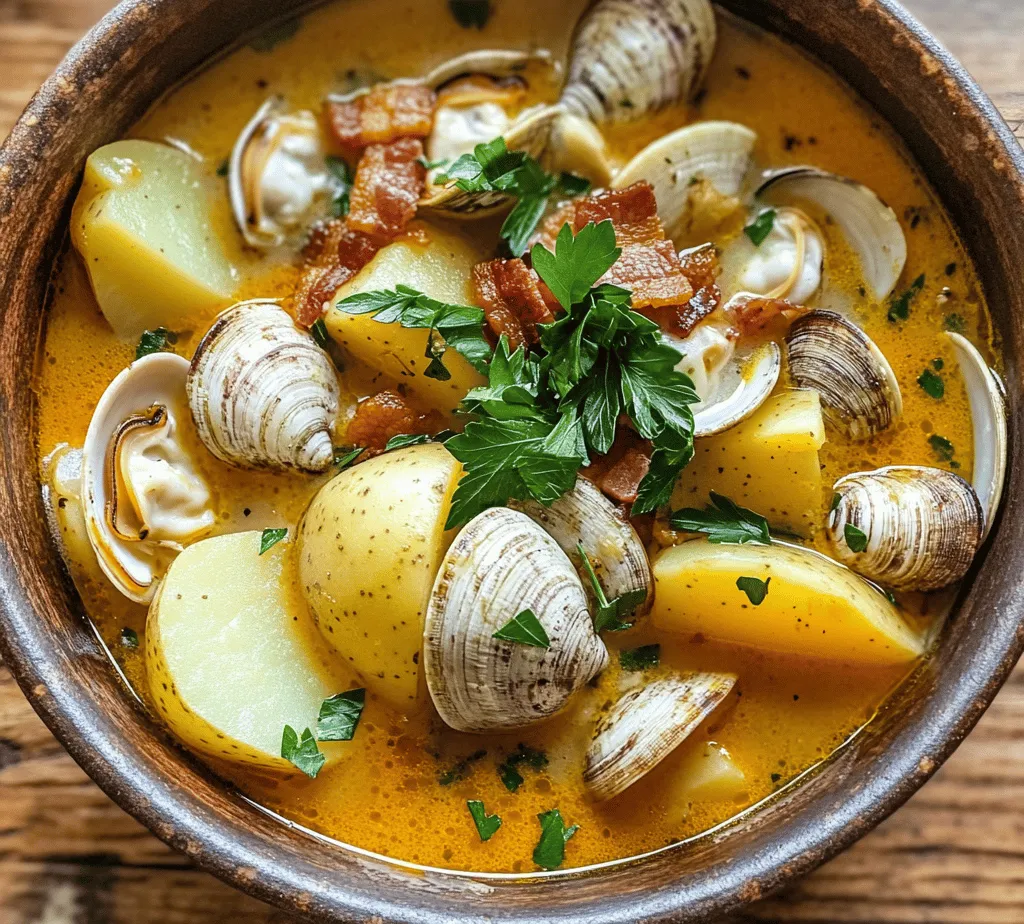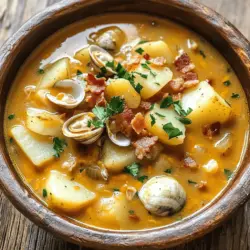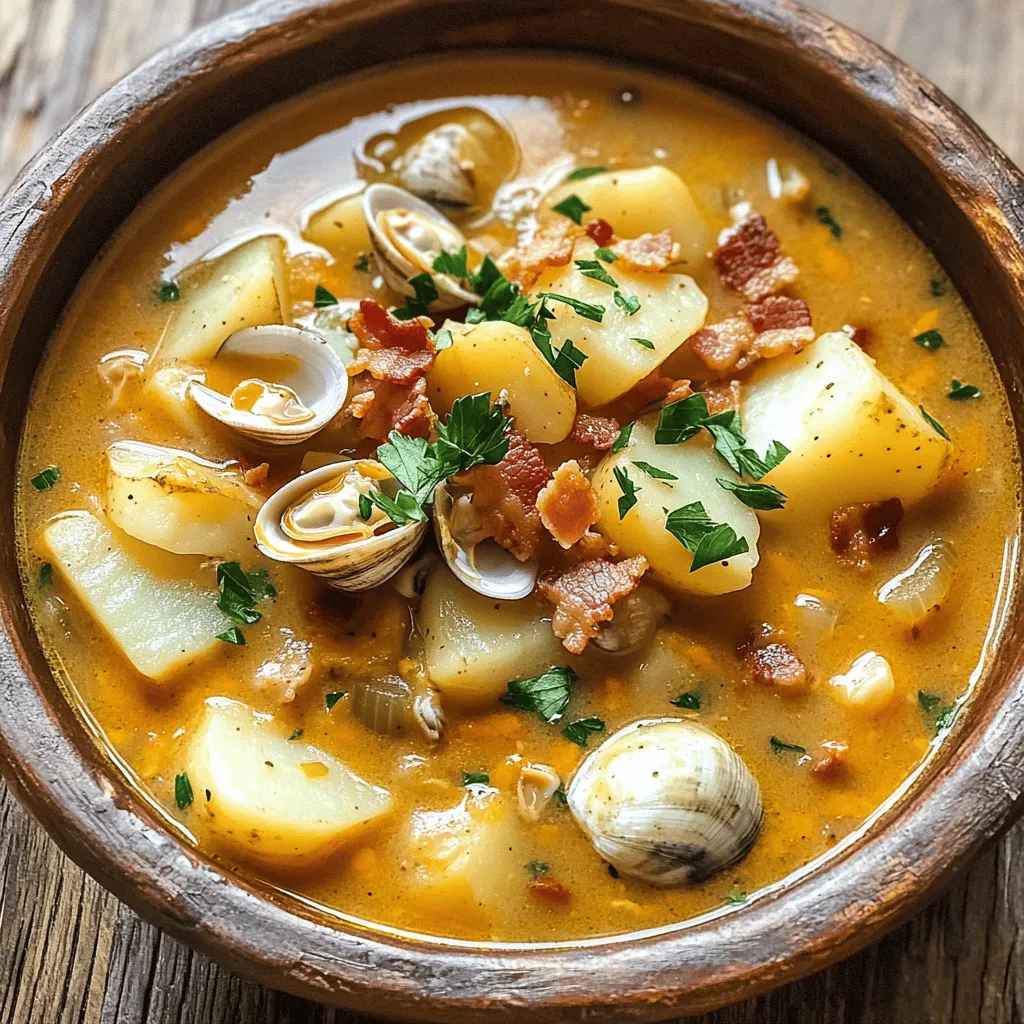Introduction
New England Clam Chowder is more than just a bowl of soup; it’s a beloved classic that embodies the essence of coastal New England cuisine. This creamy, hearty dish is a staple in many homes and restaurants, especially during the chilly months when its comforting warmth is most welcome. Originating from the northeastern United States, clam chowder has become synonymous with New England, celebrated for its rich flavors and satisfying texture.
Historically, clam chowder has deep roots in the maritime traditions of New England. It is believed that early settlers adapted recipes from Native Americans, who would make chowders using clams, fish, and other local ingredients. Over the years, the recipe has evolved, but the core elements remain the same: clams, potatoes, onions, and a creamy base. Today, it is a dish that unites families and friends, often enjoyed in seaside shacks or during festive gatherings.
The allure of New England Clam Chowder lies in its creamy texture, which envelops tender pieces of clam and hearty vegetables, creating a dish that is as comforting as it is delicious. The combination of salty, briny clams with rich cream and smoky bacon creates a symphony of flavors that dance on the palate. Whether served with oyster crackers or a warm piece of crusty bread, this chowder is a perfect way to warm up on a cold day.
Ingredients Breakdown
Understanding the ingredients is essential for mastering the art of making New England Clam Chowder. Each component plays a crucial role in developing the dish’s signature flavor profile.
Key Ingredients
1. Clams: The star of the show, clams provide the distinctive briny flavor that defines this chowder. Fresh clams are ideal for the best taste, with varieties such as cherrystone or littleneck being popular choices. However, canned clams can also be used for convenience, especially when fresh clams are not available. When opting for canned clams, look for high-quality brands that include their juice for added flavor.
2. Bacon: A touch of bacon brings a smoky depth to the chowder. The choice of bacon can significantly influence the final flavor. Thick-cut bacon is preferred for its meatiness and ability to render a good amount of fat, which is essential for sautéing the aromatics. Regular bacon can be used, but it may not deliver the same richness.
3. Potatoes: Potatoes add heartiness to the chowder. Waxy varieties like Yukon Gold or red potatoes are best because they hold their shape well during cooking. Avoid starchy potatoes like Russets, as they can become mushy and alter the texture of the chowder.
4. Aromatics: Onions and celery are the backbone of flavor in this dish. They provide a subtle sweetness and depth that enhance the overall taste.
5. Cream: Heavy cream is a must for achieving that luxurious, velvety texture that New England Clam Chowder is famous for. This is what transforms a simple broth into a rich, satisfying dish.
6. Clam Juice: Utilizing clam juice is crucial for maximizing the seafood flavor. It can be made by steaming the clams and reserving the liquid or purchased canned. This broth infuses the chowder with even more clam essence.
7. Seasoning: Salt, pepper, and fresh thyme are typically used to season the chowder, enhancing the flavors without overpowering the natural sweetness of the clams.
Nutritional Aspects
While New England Clam Chowder is often considered a comfort food indulgence, it does offer some nutritional benefits. Clams are an excellent source of protein, low in calories, and packed with essential vitamins and minerals such as vitamin B12, iron, and omega-3 fatty acids. The inclusion of potatoes adds fiber and potassium, while celery and onions contribute to your daily vegetable intake. However, it’s important to keep in mind that the cream and bacon do add saturated fat and calories, so moderation is key if you’re watching your diet.
Preparation Steps
Creating a delicious New England Clam Chowder requires attention to detail during the preparation stage. Each step is crucial for developing a rich and satisfying final product.
Step 1: Sautéing the Bacon
Begin by cutting the thick-cut bacon into small pieces. In a large pot or Dutch oven, over medium heat, add the bacon and allow it to cook until it becomes crispy. This can take about 5-7 minutes. The goal here is not only to cook the bacon but also to render its fat, which will serve as the foundation for sautéing the vegetables. Use a slotted spoon to remove the bacon once it’s crisp, leaving the rendered fat in the pot, which will infuse your chowder with smoky flavor.
Step 2: Cooking the Aromatics
With the bacon fat still in the pot, add diced onions and chopped celery. Sauté them over medium heat for about 5 minutes, or until the onions become translucent and fragrant. This step is essential, as it builds the flavor base of the chowder, allowing the sweet notes of the onion and the aromatic qualities of the celery to meld together beautifully.
Step 3: Incorporating Flour
Once the aromatics are tender, sprinkle in flour (about 1/4 cup) over the sautéed vegetables. Stir constantly for 1-2 minutes to cook the flour, which will help thicken the chowder later on. This step is crucial: if the flour is not cooked adequately, it can result in a lumpy texture. To avoid lumps, ensure that the flour is evenly distributed, and keep stirring until it forms a paste with the bacon fat and vegetables.
Step 4: Adding Clam Juice
Next, gradually pour in the reserved clam juice, stirring continuously to prevent lumps from forming. This will create a smooth broth. If you don’t have enough clam juice, feel free to supplement with vegetable or chicken broth. Bring the mixture to a gentle simmer, allowing it to thicken slightly. This process usually takes about 5 minutes.
Step 5: Incorporating Potatoes
Now it’s time to add the diced potatoes to the pot. Make sure to cut them into uniform pieces for even cooking. Stir them in, then add additional broth if necessary to ensure the potatoes are fully submerged. Simmer the chowder for about 10-15 minutes until the potatoes are tender but not mushy. The type of potatoes you choose can affect the overall texture of the chowder; waxy potatoes will hold their shape, contributing to a more satisfying bite.
Step 6: Final Touches with Clams and Cream
Once the potatoes are tender, it’s time to add the clams back to the pot. If using fresh clams, ensure they are cleaned and prepped. Stir in the cooked clams and heavy cream, allowing the chowder to simmer gently for an additional 5-10 minutes. This is where the chowder transforms into a creamy delight. Be careful not to boil vigorously at this stage, as it can curdle the cream.
Cooking Techniques
Understanding the cooking techniques involved in making New England Clam Chowder is essential for achieving the best results.
Sautéing vs. Simmering
Sautéing is used at the beginning of the recipe to develop flavors through caramelization, particularly of the bacon and aromatics. This is where the dish begins to build its depth of flavor. Once the chowder base is established, simmering takes over to meld the flavors together and cook the ingredients through. Simmering is a gentler cooking method that allows for the gradual infusion of flavors, ensuring that each ingredient shines without being overcooked.
The Role of Simmering in Flavor Development
The optimal simmering time for chowder is generally around 20-30 minutes, allowing the ingredients to meld together beautifully. This process not only helps the potatoes soften but also allows the flavors to deepen. The key is to maintain a low simmer; boiling can break down the delicate ingredients and alter the texture of the chowder.
By following these preparation steps and understanding the role of each ingredient, you can create a New England Clam Chowder that is both rich in flavor and comforting to the soul. Stay tuned for the next part, where we’ll dive deeper into serving suggestions and tips for perfecting this classic dish!

Importance of Seasoning: Balancing Salt and Pepper for the Best Flavor Profile
When it comes to crafting the perfect New England Clam Chowder, seasoning plays a pivotal role in enhancing the depth and complexity of flavors. While the base ingredients—clams, potatoes, and cream—offer a delectable foundation, the right balance of salt and pepper can elevate the dish from good to unforgettable. Start by adding a modest amount of sea salt and freshly cracked black pepper to the chowder as it simmers, tasting periodically to adjust as necessary. Remember, the clams themselves bring a natural brininess, so it’s essential to season judiciously. The key is to layer your flavors gradually, allowing the dish to develop its character as it cooks.
Flavor Enhancements
To take your New England Clam Chowder to the next level, consider incorporating optional ingredients that add both flavor and texture. Here are some ideas:
- Garlic: A few cloves of minced garlic can introduce a subtle richness and depth to the chowder. Sauté it with the onions for a fragrant base.
- Corn: Sweet corn kernels can contribute a delightful burst of sweetness and texture. Adding fresh, frozen, or canned corn towards the end of cooking will provide a lovely contrast to the creaminess of the chowder.
- Herbs: Fresh herbs, such as thyme or parsley, can brighten the dish. Add a pinch of dried thyme early in the cooking process and finish with fresh parsley just before serving to enhance the overall flavor profile.
Suggestions for Garnishes: Elevating the presentation of your chowder can be achieved with thoughtful garnishes. Consider topping each bowl with:
- Crumbled bacon or pancetta: For a savory crunch, add some crispy bacon on top.
- Chopped chives or dill: These herbs not only add a pop of color but also fresh flavor.
- A drizzle of high-quality olive oil or truffle oil: For a touch of elegance, drizzle a bit of flavored oil over the chowder just before serving.
Discussion on Adjusting Thickness: The thickness of clam chowder is a matter of personal preference. If you prefer a creamier, thicker consistency, consider these adjustments:
- More cream: Adding extra heavy cream or half-and-half can create a richer chowder.
- Flour: If you desire a thicker base, you can make a roux by cooking equal parts flour and butter before adding your other ingredients.
- Broth: Conversely, if you find the chowder too thick, simply add more clam juice or broth to reach your desired consistency.
Serving Suggestions
New England Clam Chowder is a dish that shines when paired with the right accompaniments. Here are some suggestions to enhance your chowder experience:
- Crusty Bread: A warm, crusty baguette or rustic sourdough is perfect for dipping into the chowder. The bread absorbs the creamy broth and complements the richness of the dish.
- Oyster Crackers: These classic companions provide a satisfying crunch and are a traditional topping for clam chowder, adding texture to each bite.
Ideal Occasions for Serving Chowder: This comforting dish is perfect for various occasions:
- Seasonal Celebrations: Enjoy clam chowder during the cooler months, especially in fall and winter when hearty soups are particularly inviting.
- Festive Gatherings: Serve it at holiday dinners or family gatherings as a warm starter that sets a cozy tone for the meal.
Presentation Tips: To make your clam chowder visually appealing, consider these presentation ideas:
- Use wide, shallow bowls to showcase the chowder’s creamy texture and garnishes.
- Add a sprinkle of fresh herbs or a dash of smoked paprika for a pop of color.
- Serve with a side of crusty bread presented on a wooden board for a rustic touch.
Storage and Reheating Tips
Leftover clam chowder is a delicious treat, but proper storage and reheating are crucial to maintaining its flavor and texture.
Best Practices for Storing Leftover Clam Chowder:
- Allow the chowder to cool completely before transferring it to an airtight container.
- Store it in the refrigerator for up to 3 days. If you plan to keep it longer, consider freezing it.
How to Safely Reheat Without Compromising Texture and Flavor:
- Reheat the chowder gently on the stovetop over low heat, stirring frequently. Avoid boiling, as this can cause the cream to separate.
- If reheating from frozen, thaw it in the refrigerator overnight before warming it on the stovetop.
Discussion on Freezing Clam Chowder:
- While clam chowder can be frozen, it’s important to note that the texture may change upon thawing. To minimize this, consider freezing the broth and clams separately from the cream and potatoes. This way, you can combine them after reheating for the best result.
Cultural Significance and Variations
Clam chowder holds a cherished place in American culinary tradition, particularly in New England. Its history is rich, and its variations reveal the diverse tastes and regional influences across the country.
Exploration of Different Regional Variations:
- Manhattan Clam Chowder: Unlike its creamy New England counterpart, Manhattan clam chowder features a tomato-based broth. This variation offers a different flavor profile that many enjoy, but purists often favor the richness of the New England style.
- New England Clam Chowder Evolution: Over time, this dish has evolved, incorporating local ingredients and personal touches. Today, you may find variations that include different types of seafood or even spicy elements for a modern twist.
The Chowder’s Place in American Culinary Tradition:
Clam chowder is not just a dish; it represents a cultural connection to the sea and the rich maritime history of New England. It embodies the spirit of community, often enjoyed in family gatherings and festive occasions, making it a beloved staple in American cuisine.
Conclusion
Homemade New England Clam Chowder is a comforting, flavorful dish that captures the essence of coastal dining. The combination of tender clams, creamy broth, and hearty potatoes creates a satisfying experience that warms the soul. By incorporating thoughtful seasoning, flavorful enhancements, and proper serving suggestions, you can create a chowder that delights both the eyes and the palate.
We encourage you to try this recipe at home, embracing the joy of cooking and the pleasure of sharing a classic dish with family and friends. Whether enjoyed on a chilly evening or served at a festive gathering, New England Clam Chowder is a recipe that promises to bring warmth and satisfaction to your table. Dive into this culinary adventure and savor the rich flavors that have made this chowder a timeless favorite!


